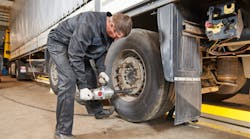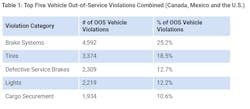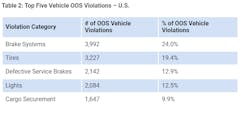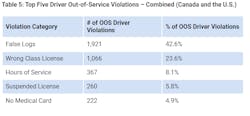Roadside inspectors put more than 12,000 commercial vehicles and nearly 4,000 commercial drivers out of service during the Commercial Vehicle Safety Alliance’s International Roadcheck. With a focus on wheel-ends this year, CVSA-certified inspectors conducted about 59,000 inspections during the three-day blitz.
The most common vehicle violations were for brake systems, tires, defective service brakes, lights, and cargo securement. False logs put more than 1,900 drivers out of service, and another 1,000 were cited for driving with the wrong class license. Hours of service, suspended license, and no medical card rounded out the top five reasons for driver violations.
See also: Wheel-end monitors: Tech that helps avoid costly ‘thermal events’
A commercial motor vehicle is placed out of service when an inspector finds critical vehicle violations—detailed in CVSA’s North American Standard Out-of-Service Criteria—during an inspection. Drivers and vehicles out of service cannot operate for a certain period or until the violation is corrected.
The vehicles that pass Level I or V inspections are eligible for a CVSA decal, which can be affixed to the vehicle and is valid for up to three months. During the May Roadcheck, inspectors distributed 14,200 decals, which show future inspectors that the truck had recently passed. CMVs had a 77.2% passing rate, and 93.6% of drivers did not receive out-of-service violations.
More inspection stats
On May 17-19, inspectors performed 58,287 North American Standard Inspections, consisting of:
36,555 Level I Inspections: This 37-step process checks the driver’s operating credentials and requirements and the vehicle’s mechanical fitness and regulatory compliance.
12,411 Level II Inspections: This inspection involves reviewing the driver’s operating credentials and requirements and includes only vehicle inspection items that can be inspected without the inspector physically getting under the vehicle.
8,171 Level III Inspections: This is the driver credentials and operating requirements inspection.
1,150 Level V Inspections: This inspection involves vehicle inspection items and may be conducted at any location without a driver present.
Level I inspections
Inspectors in Canada and the U.S. primarily conduct the Level I inspection during International Roadcheck. The 37-step process involves a thorough inspection of the vehicle and the driver’s operating credentials.
Of the 36,555 Level I Inspections conducted in Canada and the U.S., 23.7% of the vehicles inspected (8,672) were placed out of service, and 6.1% (2,242) of drivers were placed out of service.
In the U.S., of the 33,196 Level I Inspections conducted, 7,912 commercial motor vehicles (23.8%) and 2,051 drivers (6.2%) were placed out of service.
In Canada, of the 3,359 Level I Inspections conducted, 760 commercial motor vehicles (22.6%) and 191 (5.7%) drivers were placed out of service.
Level V inspections
Inspectors in Mexico conducted 1,150 Level V Inspections. The Level V Inspection includes each of the vehicle inspection items specified under the North American Standard Level I inspection and may be conducted without a driver present. Thirty-six commercial motor vehicles were placed out of service, which is a 3.1% out-of-service rate.







